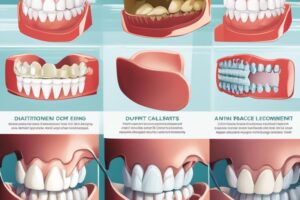Ensuring proper oral hygiene is essential for maintaining a healthy mouth and preventing potential dental issues down the line. By incorporating regular brushing and flossing into your daily routine, you can effectively remove plaque and food particles that can lead to cavities and gum disease. In this blog post, we will provide you with important information and tips on how to properly care for your teeth and gums. From the correct brushing technique to the importance of regular dental check-ups, you will learn everything you need to know to keep your oral health in top condition. So, let’s dive into the world of oral hygiene and discover how you can maintain a sparkling, healthy smile.
Key Takeaways:
- Consistent brushing: Regular brushing at least twice a day is crucial for removing plaque and preventing tooth decay and gum disease.
- Proper flossing: Flossing helps remove food particles and plaque from between teeth and along the gumline, reducing the risk of cavities and gum disease.
- Regular dental check-ups: Visiting the dentist for regular cleanings and exams is essential for maintaining proper oral hygiene and addressing potential issues early on.
Understanding Oral Hygiene
While most people know that proper oral hygiene is important, not everyone understands exactly what it entails. In this chapter, we will break down the key aspects of oral hygiene and why it is crucial for your overall health.
What is Oral Hygiene?
Oral hygiene refers to the practice of keeping your mouth, teeth, and gums clean and healthy to prevent dental problems and bad breath. It involves regular brushing and flossing, as well as visiting your dentist for routine check-ups and cleanings. By maintaining good oral hygiene, you can prevent the buildup of plaque and tartar, which can lead to tooth decay, gum disease, and other oral health issues.
The Impact of Poor Oral Hygiene
If you neglect your oral hygiene, the consequences can be serious. Poor oral hygiene can lead to a host of problems, including tooth decay, gum disease, bad breath, and even tooth loss. In addition to these oral health issues, research has also shown that poor oral hygiene can contribute to serious health conditions such as heart disease, diabetes, and respiratory infections. This is because the bacteria in your mouth can spread to other parts of your body, causing inflammation and increasing your risk of developing these systemic health problems.
Brushing Techniques and Best Practices
Keep your teeth and gums healthy by following proper brushing techniques and best practices. By learning the correct way to brush your teeth, you can ensure that you are effectively removing plaque and preventing dental issues.
Choosing the Right Toothbrush
When selecting a toothbrush, it is important to choose one that is the right size and bristle firmness for your mouth. Soft bristles are ideal for most people, as they are gentle on the gums and still effectively remove debris from the teeth. Make sure the head of the toothbrush comfortably fits in your mouth and can reach all areas of your teeth.
Proper Brushing Technique
When brushing your teeth, it’s essential to use the proper technique to ensure that you are effectively removing plaque and debris. Hold the toothbrush at a 45-degree angle to the gumline and use short, gentle strokes to brush the outer, inner, and chewing surfaces of your teeth. Pay close attention to the back molars and any areas where food tends to get trapped. Don’t forget to also brush your tongue to remove bacteria and freshen your breath.
Frequency and Timing of Brushing
Brush your teeth at least twice a day, in the morning and before bed, to maintain optimal oral health. By doing so, you can remove plaque before it has a chance to harden and become more difficult to remove. Additionally, brushing your teeth after eating acidic or sugary foods can help prevent damage to your enamel. Remember not to brush too hard, as aggressive brushing can damage tooth enamel and irritate the gums.
Flossing Essentials
To maintain proper oral hygiene, flossing is an essential part of your daily routine. Flossing helps to remove plaque and food particles that your toothbrush can’t reach, and it plays a crucial role in preventing gum disease and tooth decay. Let’s take a look at some important flossing essentials that you need to know.
Types of Dental Floss
When it comes to choosing dental floss, there are several options available. You can choose from waxed or unwaxed floss, flavored or unflavored, and even floss picks for added convenience. It’s important to find a type of floss that works best for you and that you feel comfortable using. Any dental professional can provide you with recommendations based on your specific needs.
- Waxed floss is less likely to shred or tear between tight teeth.
- Unwaxed floss is thinner and may be more suitable for people with crowded teeth.
- Flavored floss can make the flossing experience more enjoyable for some individuals.
- Floss picks are a convenient option for on-the-go flossing.
- Water flossers are an alternative to traditional floss and can be particularly helpful for people with braces or other dental work.
Any selection you make, the most important factor is to use a type of floss that you will use consistently as part of your oral hygiene routine.
Correct Flossing Method
When it comes to flossing, using the correct technique is crucial for removing plaque and debris effectively. Start by breaking off about 18 inches of floss and wrapping the ends around your fingers, leaving a couple of inches between them to work with. Gently guide the floss between your teeth using a back-and-forth motion, making sure to clean below the gum line. Be careful not to snap or force the floss, as this can cause irritation to your gums. As you move to the next tooth, use a clean section of floss to avoid transferring bacteria. It’s important to floss between all of your teeth and behind your back molars as well.
The Role of Flossing in Gum Health
Flossing plays a critical role in maintaining gum health. When plaque and debris are left between your teeth, it can lead to gum inflammation and eventually, gum disease. By incorporating flossing into your daily routine, you can effectively remove these harmful particles and prevent the buildup of plaque. This will not only contribute to the health of your gums but also reduce the risk of developing cavities between your teeth. Committing to regular flossing can significantly improve your overall oral hygiene and contribute to a healthier smile.
Advanced Oral Care Strategies
After establishing a solid foundation with regular brushing and flossing, you may want to explore more advanced oral care strategies to further improve your dental health. Here are some tips to consider:
- 11 Ways to Keep Your Teeth Healthy: Check out this comprehensive guide for additional ways to maintain healthy teeth and gums. It covers everything from diet and nutrition to dental hygiene practices.
- Utilize advanced oral care products such as electric toothbrushes or water flossers. These tools can help provide a more thorough clean and reduce the risk of plaque and tartar buildup.
- Consider investing in a mouthguard if you participate in contact sports or grind your teeth at night. Protecting your teeth from physical trauma can prevent serious damage.
By incorporating these advanced strategies into your oral care routine, you can elevate your dental health to the next level and enjoy the benefits of a confident, healthy smile.
Mouthwash and Fluoride Treatments
Using mouthwash containing fluoride can be an effective way to strengthen your tooth enamel and fight against decay. Fluoride treatments at your dentist’s office can also provide an extra layer of protection for your teeth, reducing the risk of cavities and other dental issues.
Fighting Plaque and Tartar Buildup
Plaque and tartar buildup can lead to serious dental problems if left untreated. To combat these issues, consider using an anti-plaque mouthwash or toothpaste containing fluoride. Additionally, scheduling regular professional cleanings with your dentist can help remove stubborn plaque and tartar, preventing potential complications.
Conclusion: Proper Oral Hygiene Practices, Such as Brushing and Flossing
So, maintaining proper oral hygiene practices such as brushing and flossing is crucial for keeping your teeth and gums healthy. By brushing your teeth twice a day and flossing regularly, you can prevent plaque buildup, cavities, and gum disease. Remember to use fluoride toothpaste and spend at least two minutes brushing each time. Don’t forget to replace your toothbrush every three to four months or sooner if the bristles are frayed. Incorporating these habits into your daily routine will help you maintain a healthy smile and prevent potential dental issues in the future.
Proper Oral Hygiene Practices FAQ
Q: Why is proper oral hygiene important?
A: Proper oral hygiene is important to prevent tooth decay, gum disease, and bad breath. It also helps maintain overall health by reducing the risk of heart disease, diabetes, and other health issues.
Q: How often should I brush my teeth?
A: It is recommended to brush your teeth at least twice a day, in the morning and before bed. Some people may benefit from brushing after meals as well.
Q: How long should I brush my teeth for?
A: You should brush your teeth for at least two minutes each time. Use a timer or a toothbrush with a built-in timer to ensure you are brushing for the correct amount of time.
Q: Is flossing really necessary?
A: Yes, flossing is an essential part of proper oral hygiene. It helps remove plaque and food particles from between the teeth and along the gumline, where your toothbrush cannot reach.
Q: What is the correct technique for brushing and flossing?
A: When brushing, hold your toothbrush at a 45-degree angle to your gums and use small circular motions. When flossing, gently glide the floss between your teeth and curve it around each tooth, making sure to go beneath the gumline.







